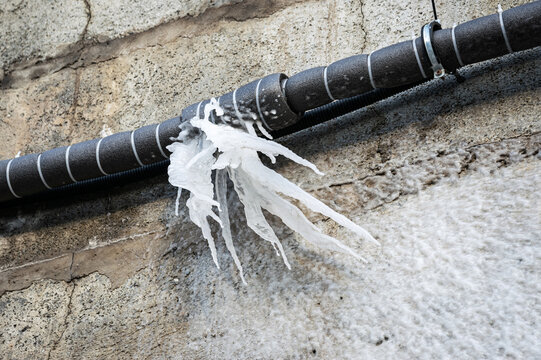Tips for Preventing Frozen Pipes in Winter: Professional Insights
Tips for Preventing Frozen Pipes in Winter: Professional Insights
Blog Article
We have encountered this article pertaining to 6 Ways to Prevent Frozen Pipes directly below on the web and thought it made good sense to relate it with you in this article.
:strip_icc()/snow-outdoor-faucet-pipes-4af65d1e5e904fb1aa7bf74071fe5d89.jpg)
Winter can ruin your plumbing, particularly by freezing pipelines. Here's just how to prevent it from occurring and what to do if it does.
Introduction
As temperature levels decrease, the danger of frozen pipes boosts, potentially leading to expensive repairs and water damages. Comprehending just how to stop frozen pipes is critical for property owners in chilly environments.
Understanding Icy Pipes
What causes pipelines to freeze?
Pipes ice up when subjected to temperatures below 32 ° F (0 ° C) for extended periods. As water inside the pipelines freezes, it increases, taxing the pipeline walls and possibly triggering them to burst.
Risks and problems
Icy pipelines can cause water system interruptions, residential property damage, and pricey repair services. Burst pipes can flood homes and cause extensive architectural damage.
Signs of Frozen Pipes
Recognizing icy pipelines early can stop them from breaking.
Exactly how to determine icy pipes
Look for lowered water flow from faucets, uncommon odors or noises from pipes, and visible frost on subjected pipelines.
Prevention Tips
Shielding at risk pipes
Wrap pipes in insulation sleeves or make use of warmth tape to safeguard them from freezing temperature levels. Focus on pipelines in unheated or outside locations of the home.
Home heating strategies
Keep interior spaces appropriately warmed, particularly areas with plumbing. Open cupboard doors to permit cozy air to distribute around pipes under sinks.
Shielding Exterior Plumbing
Garden hoses and outdoor taps
Detach and drain pipes garden pipes before winter. Mount frost-proof spigots or cover outdoor faucets with shielded caps.
What to Do If Your Pipes Freeze
Immediate actions to take
If you suspect frozen pipelines, keep taps open up to eliminate stress as the ice melts. Use a hairdryer or towels soaked in hot water to thaw pipes slowly.
Long-Term Solutions
Structural changes
Take into consideration rerouting pipes away from exterior wall surfaces or unheated locations. Include extra insulation to attic rooms, cellars, and crawl spaces.
Updating insulation
Buy top notch insulation for pipes, attic rooms, and wall surfaces. Proper insulation helps keep regular temperatures and minimizes the threat of icy pipelines.
Final thought
Protecting against frozen pipelines calls for aggressive procedures and fast feedbacks. By comprehending the causes, indicators, and safety nets, homeowners can shield their pipes throughout cold weather.
6 Proven Ways to Prevent Frozen Pipes and Protect Your Home
Disconnect and Drain Garden Hoses
Before winter arrives, start by disconnecting your garden hoses and draining any remaining water. Close the shut-off valves that supply outdoor hose bibs and leave the outdoor faucet open to allow any residual water to drain. For extra protection, consider using faucet covers throughout the colder months. It’s also important to drain water from any sprinkler supply lines following the manufacturer’s directions.
Insulate Exposed Pipes
Insulating your pipes is an effective way to prevent freezing. Pipe insulation is readily available at home improvement stores and is relatively inexpensive. Pay close attention to pipes in unheated areas such as the attic, basement, crawl spaces, or garage. Apply foam insulation generously to create a buffer against the cold. You can also wrap your pipes in heat tape or thermostat-controlled heat cables for added warmth.
Seal Air Leaks
Inspect your home for any cracks or openings that could let in cold air. Seal any holes around the piping in interior or exterior walls, as well as the sill plates where your home rests on its foundation. Additionally, make sure to keep your garage door closed unless you’re entering or exiting. Leaving it open creates a significant air leak that can lead to frozen pipes.
Allow Warm Air Circulation
During cold snaps, it’s essential to allow warm air to circulate evenly throughout your home. Leave interior doors ajar to promote better airflow. Open kitchen and bathroom cabinets to help distribute heat consistently around the rooms. If you have small children or pets, be sure to remove any household chemicals or potentially harmful cleaners from open cabinets for safety.
Let Faucets Drip
A small trickle of water can make a big difference in preventing ice formation inside your pipes. When temperatures drop significantly, start a drip of water from all faucets served by exposed pipes. This continuous flow helps prevent the water from freezing. Additionally, running a few faucets slightly can relieve pressure inside the pipes, reducing the chances of a rupture if the water inside does freeze.
https://choateshvac.com/6-proven-ways-to-prevent-frozen-pipes-and-protect-your-home/

As an avid person who reads about How to prepare your home plumbing for winter weather, I imagined sharing that segment was really helpful. So long as you enjoyed our blog post kindly remember to share it. I am grateful for your time. Revisit us soon.
Further Details Report this page